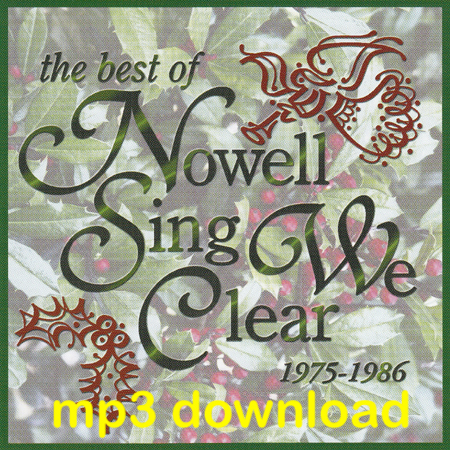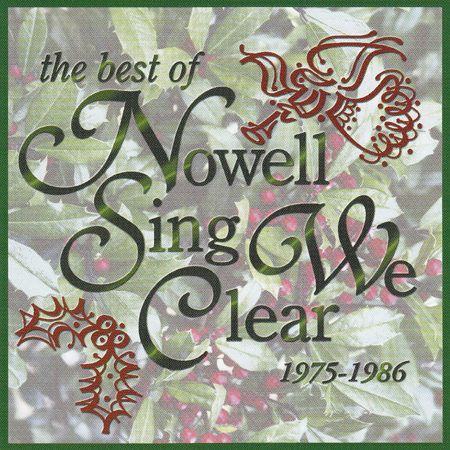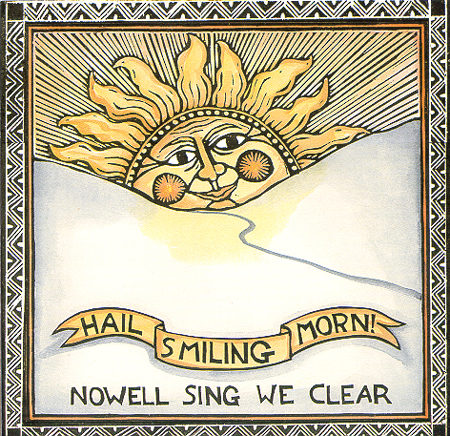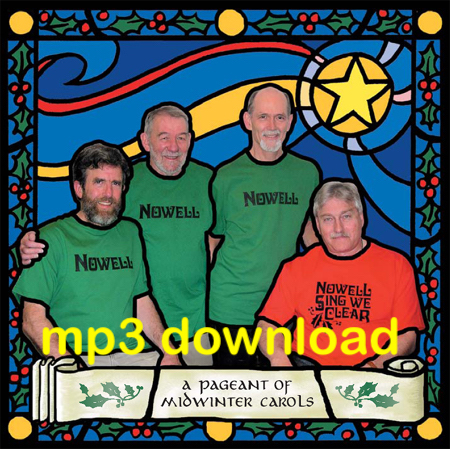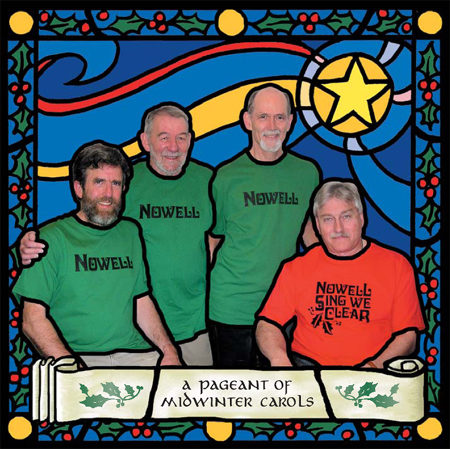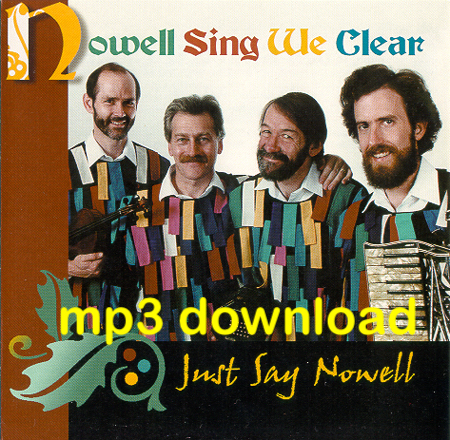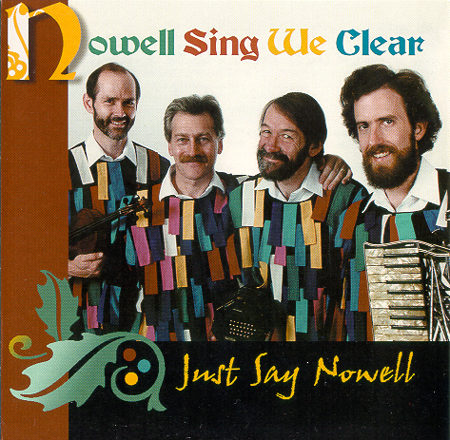Alison Burns sent us a copy of her arrangements of traditional and original carols and songs, The Merits of Gold (see http://aliburns.co.uk/books/). It was richly rewarding to explore the collection and we have used four selections in this album. We adapted Alison’s original creation Sing Nowell as a show-opener.
William Morris wrote Masters in This Hall in 1860 and set his lyrics to a French carol tune obtained by his friend, publisher Edmund Sedding, from the organist at Chartres cathedral. When Nowell Sing We Clear was first developed in 1975, we learned this and several other songs from the invaluable 1938 edition of The Oxford Book of Carols.
It was common in English churches between 1700–1850, where the style of hymnody now known for being performed in the “West Gallery” developed, for the music to be played instrumentally as well as sung. Awake! Behold! was collected in Eversley, Hampshire by Rose Yeomans and arranged in four parts by Roger Watson. We are most grateful to Sarah Morgan for sending us this arrangement, which her trio Craig Morgan Robson had adapted and recorded a cappella on their delightful CD Stranded. For our instrumental “symphony” here, Andy’s son Arthur Davis guests on trumpet.
We took The Old Hark Hark, a version of the popular hymn “Hark! Hark what news the angels bring,” from The New Oxford Book of Carols. The hymn was first published in 1732, and was written down in this form by the English folksong collector H.E.D. Hammond in 1919 as sung by the Walton (Buckinghamshire) waits. The song is a favorite among the carol singers in the South Yorkshire pubs.
I Saw a Ship. This fine poem by a Mrs. Addington was entered in a 1940 competition for new carols sponsored by The Sunday Times of London. The tune is by Alison Burns, and she thinks the poet was 18–19 years of age.
Andy Davis found the Catalonian carol Cold December, with its first two verses, in The International Book of Christmas Carols. We adapted the English text to correspond to the original Catalan rhyming pattern. Our friend Susan Digiacomo, Professor of Anthropology at Universitat Rovira in Barcelona, sent us translations of two other verses, one of which we also adopted.
Mummers Night in Oshawa, about homesick Newfoundland Mummers who moved to Oshawa in Ontario to find work, is by A. Frank Willis, a popular Canadian entertainer who performed as a one-man band. He died in 2011 but lives for evermore on YouTube.
The Watersons recorded Apple Tree Wassail in 1975 on For Pence and Spicy Ale. This blessing of fruit-bearing trees was common in the English counties of Devon and Somerset, firing gunpowder among the branches and putting a piece of toast on the roots, sometime around the New Year or Epiphany. Peter Kennedy notes that in many places in Somerset it took place on “old style” Epiphany, January 17. John thought the addition of a “village fiddler” would be just the ticket for this song, and Fred obliged.
There are probably more musical settings of Nahum Tate’s “While shepherds watched their flocks” (first published in 1700) than any other Christmas song, carol or hymn. “Zadoc” is a Cornish (West Gallery?) version. The setting is very like that of “New Jerusalem,” an American shape note piece by Jeremiah Ingalls of Newbury, VT. We tried to take the good bits from each of them to form New Zadoc. It remains an open question whether Ingalls knew “Zadoc” before writing “New Jerusalem.”
The traditional lyric of O the Holy Holly is an interesting mix of two songs relating aspects of Jesus’ birth and childhood: “The Cherry Tree Carol” and “The Holly and the Ivy.” It was collected by Thomas Miners of Camborne in Cornwall from a Mr. Landry and published without a tune in the Journal of the Folk Song Society. Alison Burns composed this tune, and we have adapted her arrangement for voices and instruments.
We first encountered the Basque carol O Bethlehem in Elizabeth Poston’s The Penguin Book of Christmas Carols. Verses 1 and 3 are from Poston and verse 2 was adapted from The International Book of Christmas Carols.
We tried Alison Burns’ setting for this carol, “O Grand and O Bright” in The Merits of Gold, but felt it was not quite right for our voices. The text and tune came from a Gloucestershire singer, Betty Aldridge, collected by our friend Gwilym Davies whose efforts had previously given us the “Stevens Family Waysail” which we recorded on Just Say Nowell. We used the original text, “How Grand and How Bright” written by William Henry Havergal (1793–1870), to expand the carol. Then, honoring the county of John’s birth, we settled on the title by which the song was commonly known, The Worcestershire Carol.
Colin Cater penned Penny for the Ploughboys for the visits by the ploughboys and the Molly dancers at the turn of the year, as the fields were prepared for the new crops. His 2009 book, also titled with the seasonal cry A Penny for the Ploughboys, contains many of his songs and relates his own story as the old ways of the English countryside became a focus for his own music.
Stay and I’ll Sing! is yet another cumulative song celebrating the twelve-ness of the midwinter season. We learned it from the remarkable collection of songs edited by Ruth Crawford Seeger as American Folksongs for Christmas, where it is called “The Twelve Apostles.” The Seeger family led by Peggy recorded it on the LP/CD set of these songs.
Over the years we have sung several versions of “The Derby Ram,” from a midwinter visiting custom in Derbyshire. The song celebrating the gargantuan proportions of this magical animal has spread far and wide, as far as Australia and even to a New Orleans Dixieland version. This one, which we call The Derby Ram Goes to Sea, comes from Joanna Colcord’s Songs of American Sailormen, from Capt. John Robinson who had published it in an article in The Bellman in 1917. Stan Hugill also gives a version in Shanties of the Seven Seas.
Alison Burns wrote both the words and tune for The Door of the Year, a new wassail to be used at the turn (the “Door”) of the year.
Andy Davis composed the tune and made the arrangement for Villagers All, the carol which gives us our title for this CD. From Kenneth Grahame’s classic The Wind in the Willows, it is sung by the field-mice at Mole End in Chapter 5. Andy introduced it at a rehearsal and we were all blown away. John was the first to recover enough to say “I want to sing it!”, and fortunately it was in his key.
—Tony Barrand & John Roberts















